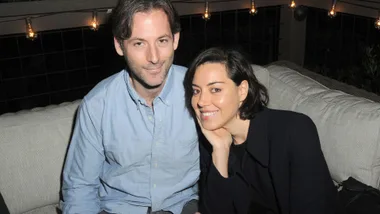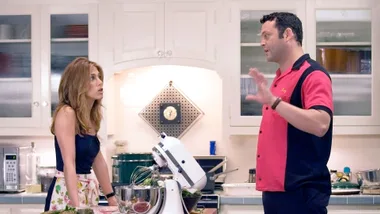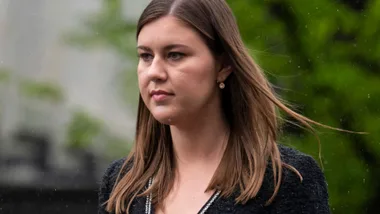For Vicky Vacondios, life could not have been happier. Raised in a strict but loving Greek family, she married in her 20s and set about establishing her own tight family unit in suburban Melbourne. Before long she was the mother of three beautiful children – two boys with a little girl, Becky, completing the perfect picture. Like many mums, she juggled motherhood with part-time work and volunteering at her kids’ school.
But when her husband became abusive, she had to flee the family home, taking the children with her. They headed to rural Victoria, where housing was at least affordable, but jobs were scarce. She was forced to return to the city within 12 months in search of paid work.
It was here she was hit with a horrific reality: she couldn’t afford to put a roof over her children’s heads. It was the beginning of a tumultuous period of homelessness for Vicky and her three kids, aged two, seven and 10, who were forced to endure months of short-term band-aid housing solutions. They moved into her sister’s home temporarily, but Vicky found couch surfing too intrusive. “I was embarrassed. I had no money but I didn’t want anyone’s help,” she admits.
Reeling from how her life had unravelled so quickly, Vicky sought out homelessness services for help. For the next three-and-a-half months, the family lived out of a series of motel rooms that currently serve as Australia’s temporary answer to emergency accommodation. “I’d take the kids to school and then race back to the service where hotel rooms were allocated on a daily basis,” Vicky recalls, explaining the stressful day-to-day hurdles she faced to keep her family safe.
Eventually they were moved into crisis accommodation, which proved an even worse experience: drugs, addiction and violence were rife, and it was difficult to see an end to the trauma. “I’d lock myself in my room at times,” Vicky, now 46, admits tearfully. Her thoughts were dark and despairing: ‘What’s the use of living? I’ve failed my kids. I’ve failed myself. I’m a terrible parent.’
Vicky’s ordinary life had turned into a living nightmare.
And it’s becoming an alarmingly familiar nightmare in Australia, where women’s homelessness has reached epidemic levels. Older women are officially the fastest-growing demographic at risk. From 2011–2016, the Census revealed a 31 per cent jump in the number of Australian women aged 55 and over who were displaced. (In Victoria the jump was 67 per cent and in NSW it was 48 per cent.)
But experts warn these official figures don’t even represent the full extent of the issue, because women’s homelessness is often shrouded by invisibility. “It’s hidden; these women aren’t visible on the street but they are homeless,” explains Jeanette Large, CEO of Women’s Property Initiatives. “They might be couch surfing, staying with friends, or living in their cars or a storage unit or severely crowded crisis accommodation.”
It’s a situation Jane Matts knows all too well. She’s a tertiary-qualified educator, change-management consultant, mum of two and law student who’s worked hard her whole life. “Even when I had kids, I only had a few months off before returning to work part-time,” she says. “At one stage in my career I was making $600 a day and travelling around Australia.”
But at age 50, Jane became homeless. “I had to start from scratch. I’d lost everything, I had nothing.” Like Vicky, she left her home due to an abusive relationship (domestic violence is the leading cause of homelessness among Australian women) and found herself shockingly and suddenly on the street. Over the years her income had been used to cover the mortgage, the kids’ child care and their living expenses, so despite having always worked, she had nothing saved. And it wasn’t safe to stay home.
She alternated between staying with friends, sleeping in her car and living out of a caravan she borrowed from her father. “It was a terrible existence,” she tells marie claire. “When you’re sleeping at night in a car park you never feel safe. Even when the car’s locked it’s like you have one eye open the whole time.”
Jane spent nine months living out of the caravan, mostly “free camping” anywhere she could park. “When I could afford it, I’d go to a caravan park for a night to have a shower and at least feel safe, but even there I’d get men knocking on my doors asking for sex. I’m in my 50s – I hate to think what younger women are subject to.”
Between taking showers in public toilets, washing her clothes in the bathroom at McDonald’s and turning up to supermarkets right before they closed to get marked-down food, Jane was trying to find work and pretend she wasn’t homeless. “You can’t look like a homeless person but you can’t afford clothes and the night before the interview you might have moved your car three times because someone knocked on the window and you couldn’t sleep.”
It was a vicious cycle and Jane says it felt like the whole system was stacked against her. “When you’ve left a violent relationship and have nowhere to live, what you really need to get back on your feet is some stability. But how do you find stability when you’ve got nowhere to live?”

According to Jan Berriman, director of National Housing & Property Development at YWCA Australia, women’s homelessness is at crisis levels. “I’ve been in the housing sector for 20-odd years and I’ve never come across the numbers we’re seeing now,” she says.
In Melbourne alone in the past eight months, women’s not-for-profit YWCA received 495 applications for emergency housing. “Of those we’ve been able to house 45. We have a turn-away rate of nearly 90 per cent – it’s just shocking,” says Jan.
So how have women – rather than the stereotype of the grizzled older man sleeping rough – become the epicentre of this crisis? Extreme housing unaffordability, in regional areas as well as urban centres, is combining with economic and gender inequality to devastating effect. “I call it a tsunami of issues coming together to peak,” says Jan. “We have unaffordable housing, not enough social or low-income housing, and the inequality women have faced over their lifetime – from the gender pay gap to low superannuation and caring duties – all manifest to a point where they can’t afford housing.”
When asked to describe the “typical” woman approaching YWCA for housing assistance, Jan is quick to answer. “She’s aged between 45–55, has worked tirelessly for most of her life, not necessarily in low-paid jobs but predominately part-time. Her work has been more intermittent because she’s often taken on the responsibility of caring for children or older relatives and supported a partner’s career.”
That description perfectly matches Kylie*, a nurse in her early 40s. The week before Christmas last year, she became homeless for the first time. “I’ve been nursing for 20 years, divorced for 12 years and had been living independently,” she says. “I never imagined this. I’m struggling to get my head around it.”
After spending the past few weeks in short-term accommodation, “two nights at the most”, she is now in a women’s shelter on Sydney’s Upper North Shore where she can stay for three months. “I have always lived week-to-week and fortnight-to-fortnight, but I had a roof over my head and my bills were getting paid. I wasn’t rich but I was managing on the borderline,” she tells marie claire.
Kylie lost her footing when she left rental accommodation last year. “It was a block of units, there was mould everywhere, lots of issues with drugs and I would often use headphones at home to block out the screaming and fighting,” Kylie explains. She suggested moving somewhere nicer and splitting the rent with another woman she’d befriended in the block. The arrangement didn’t work out and after six months when the lease was up, Kylie had nowhere to live.
“I had trusted that things would be OK,” she admits. “[The other unit] wasn’t nice but it wouldn’t be taken from me and I knew I had a bed to go to. I call it secure because even though it was run-down and there were problems, it was safe. Homelessness can happen to people with good jobs. They’re qualified, work hard and then one day their life changes.”
Jeanette agrees it often only takes one event – a job loss, an illness, an unexpected bill – to trigger a financial unravelling. “Just one thing can put women in a disastrous situation really quickly because they don’t have the financial base behind them,” she says, noting that the issue compounds for women living independently.
“When you’re single, there’s no other account you can tap into,” says Kylie, who’s feeling optimistic that her three-month stay in the Sydney shelter will help her find somewhere to live and secure work. “They do a care plan and help you work out what’s required to save for your bond and two weeks’ rent while you’re here,” she says. “I’m proactive. I can’t sit here and do nothing. I’ll do as much as I can.”
Feeling secure and supported at the shelter – as Kylie does – is critical but not always the case.
“Initially it was really nice to feel safe and have a bed. I could go to sleep with the sense that no-one would attack me,” Jane recalls of her time at a women’s refuge with her daughter. “But with so many women who are so traumatised all in one place … it’s really, really hard.”
Experts agree that for more women to avoid homelessness, systemic solutions and a wholesale commitment to solving the problems are required on several fronts. Debbie Georgopoulos, CEO of the Women’s Housing Company, reiterates that gender inequity needs to be addressed.
“If we don’t look at inequality and things like the pay gap, which over the course of a woman’s life could pay off a home, we’ll be having the exact same conversation in 20 years because the drivers of homelessness won’t have changed for women.” Policies and initiatives around superannuation, pay equity, home ownership and workforce participation that increase the capacity of women to earn more and retire with more are critical.
But Debbie adds that for older women in Australia, there is no time to rewrite the story.
“For those women who are experiencing homelessness today, they cannot turn back the clock,” she says. “We absolutely need more housing. Without new supply we cannot respond.”
It’s estimated that almost 750,000 extra social dwellings are needed in the next 20 years to meet the oncoming surge in demand for people at risk of homelessness. “These need to be built,” says Jan. “It will take a long, long time for that supply to be met. And yet the appetite in this environment from [federal and state] governments is not strong.”
It’s an issue that’s been largely ignored for decades, which is why it has reached catastrophic levels. “If the government had implemented some of the recommendations from many years ago – which was basically investment in social housing – we wouldn’t be in this situation,” Jeanette says. “Or even if the government had taken up ideas like facilitating super funds investing in the provision of social housing, we wouldn’t be here. But they weren’t interested in providing the necessary tax breaks to make that happen.”
Jeanette says we need to flip the way we think about housing. “We need a completely different approach. Housing is the stability that allows people to get on with their lives and it’s clear that people need assistance.”
There are ways to tackle this crisis: developers lending buildings to community organisations to provide housing, encouraging investment in social housing, and transitioning aged care facilities into affordable housing options. But they all require commitment.
“If something isn’t done pretty dramatically we’ll continue to see huge increases in numbers,” Jan says.
Vicky Vacondios understands this firsthand. Some eight years ago she started volunteering and working to influence politicians by talking about her experiences through public speaking. “It was work and it was empowering to be influencing policy and turning the negative into a positive,” she says. She’s also about to publish a handbook on how to help homeless or vulnerable people, aimed at community service workers but also the general public. Best of all she’s working full-time and now renting basic housing in Melbourne. Finally she has what everyone wants and deserves: a place to call home.
This article originally appeared in the marie claire April 2020 issue










